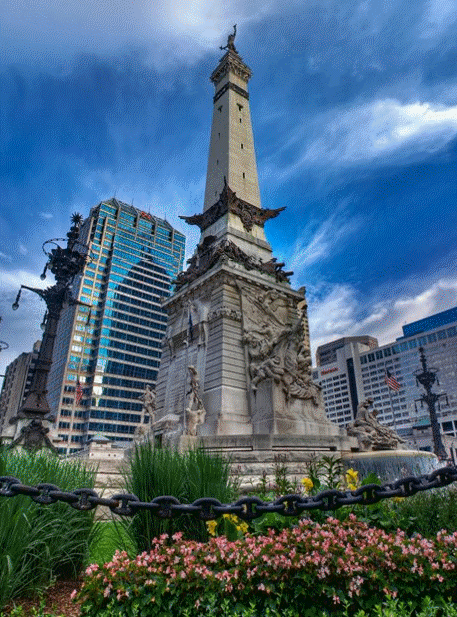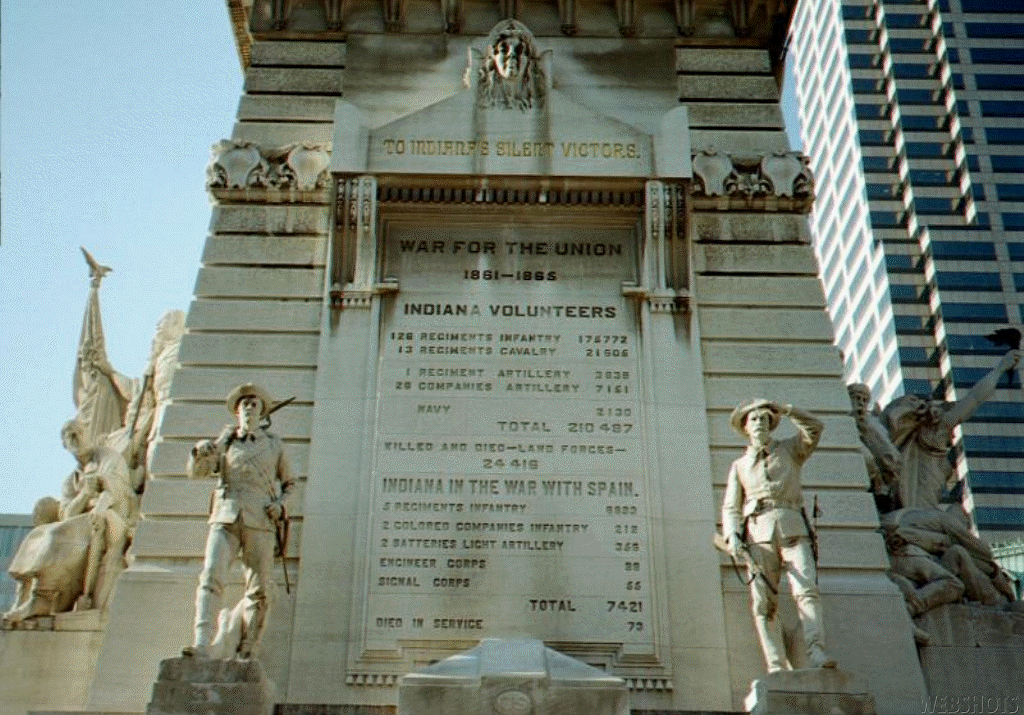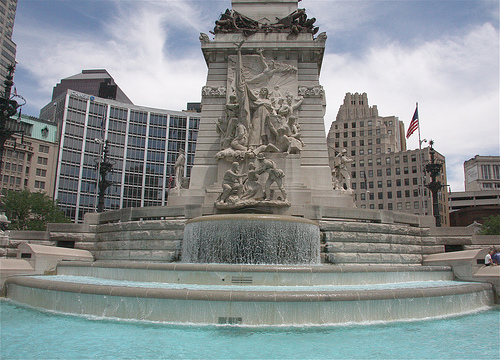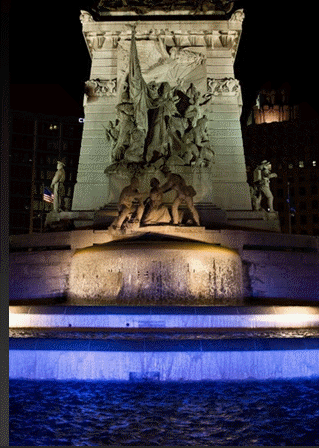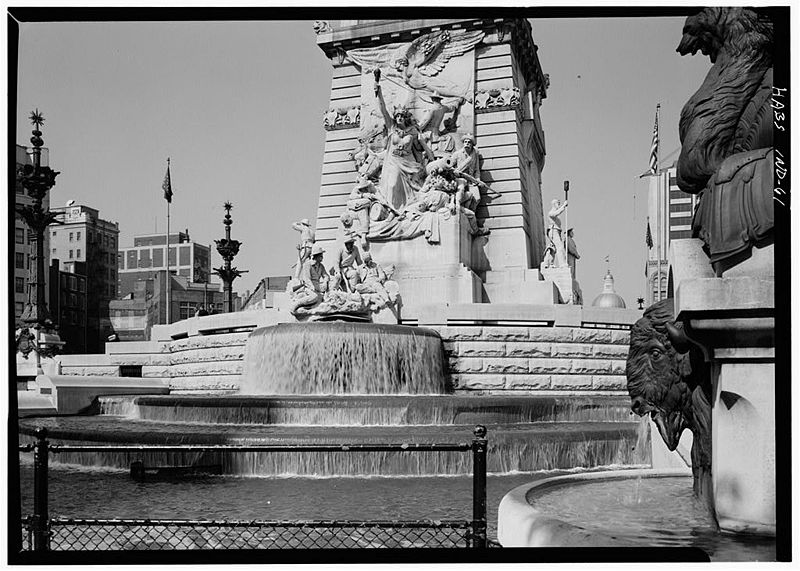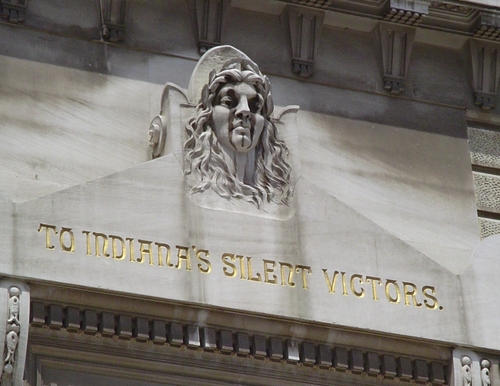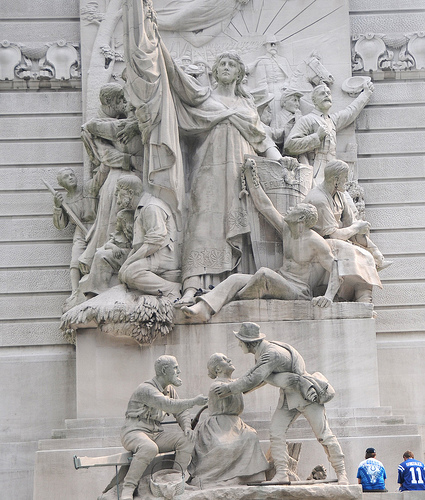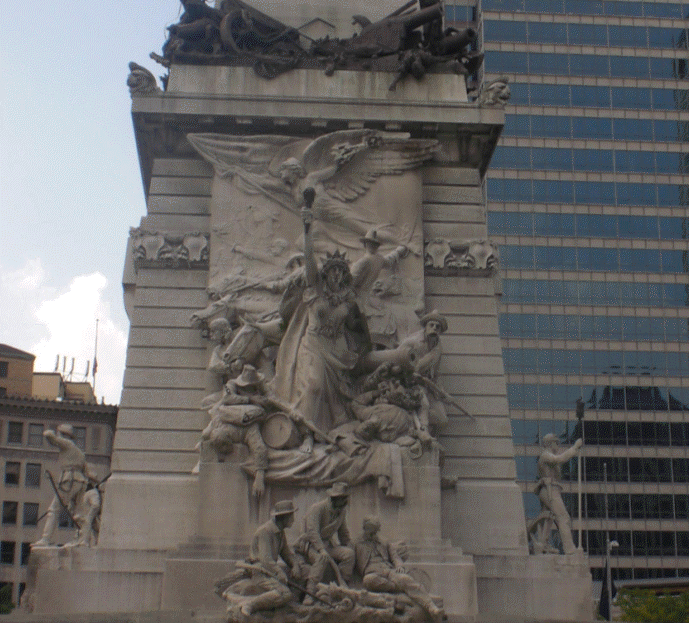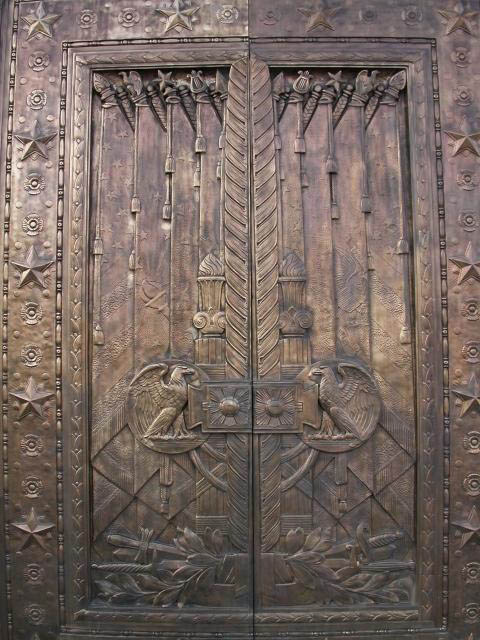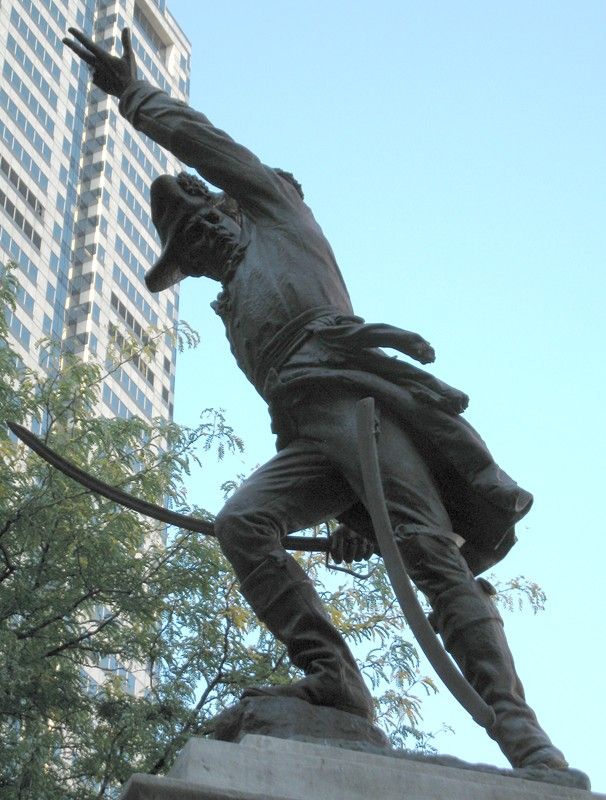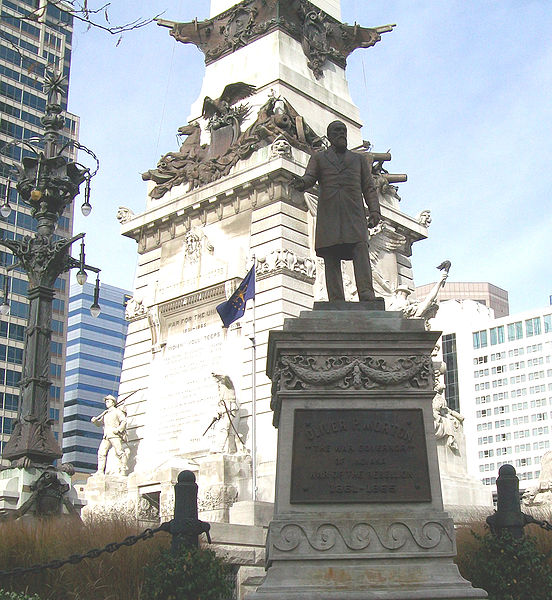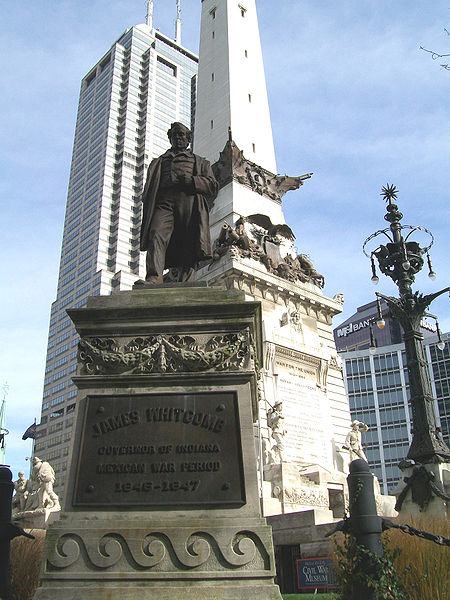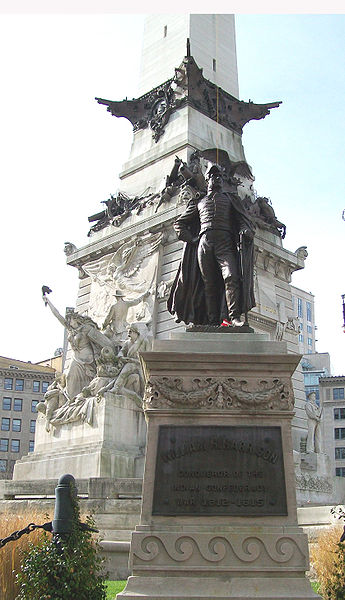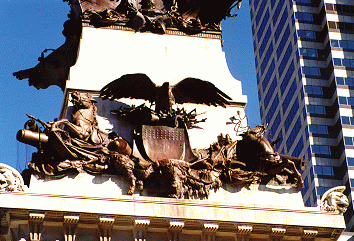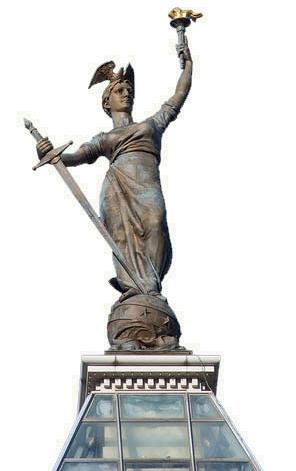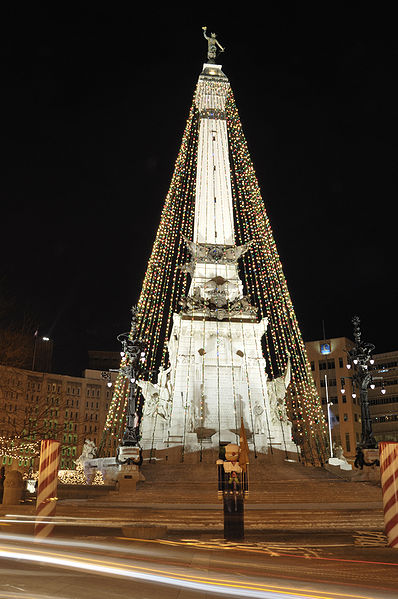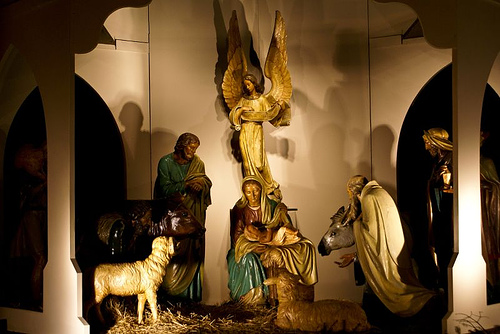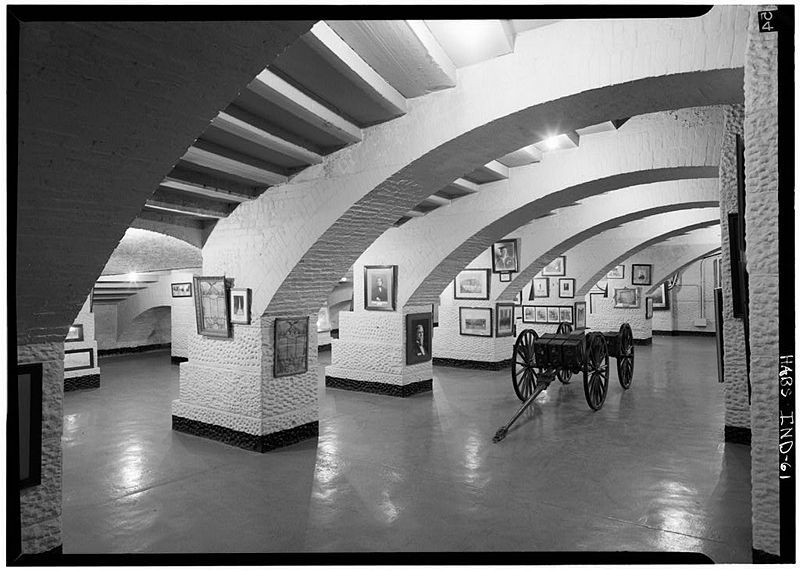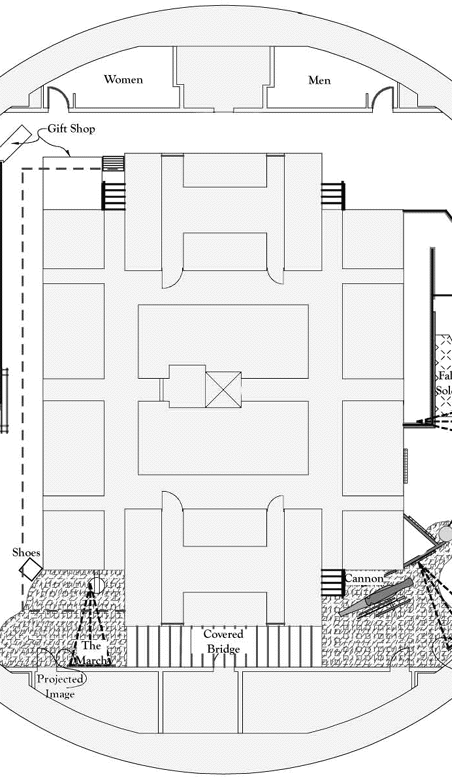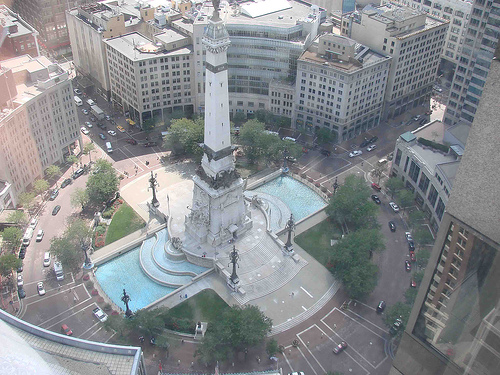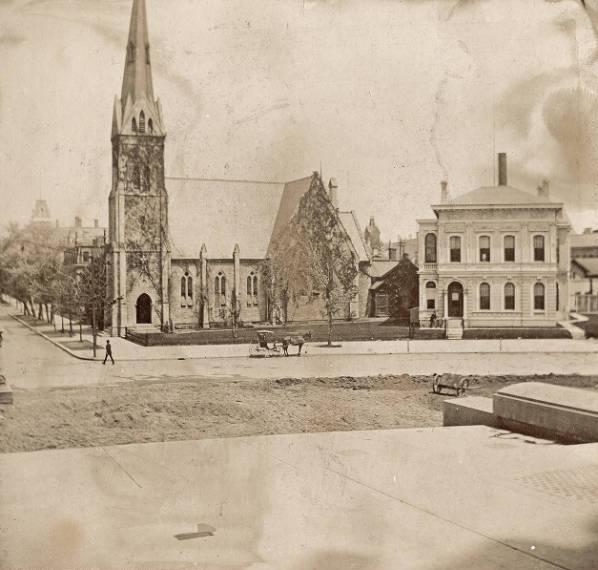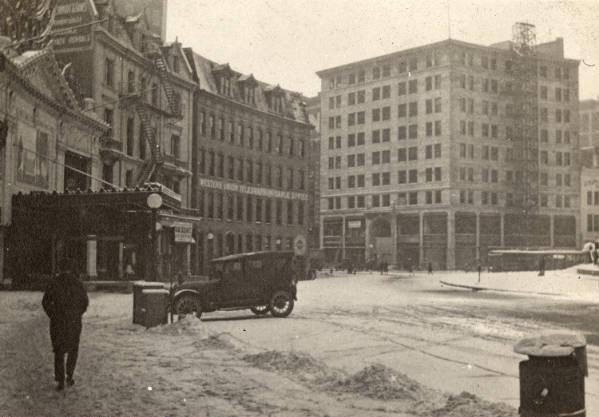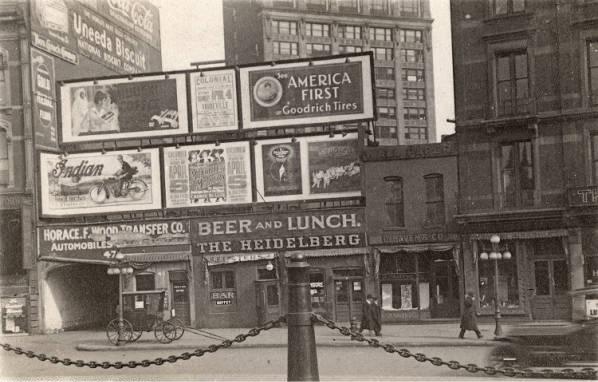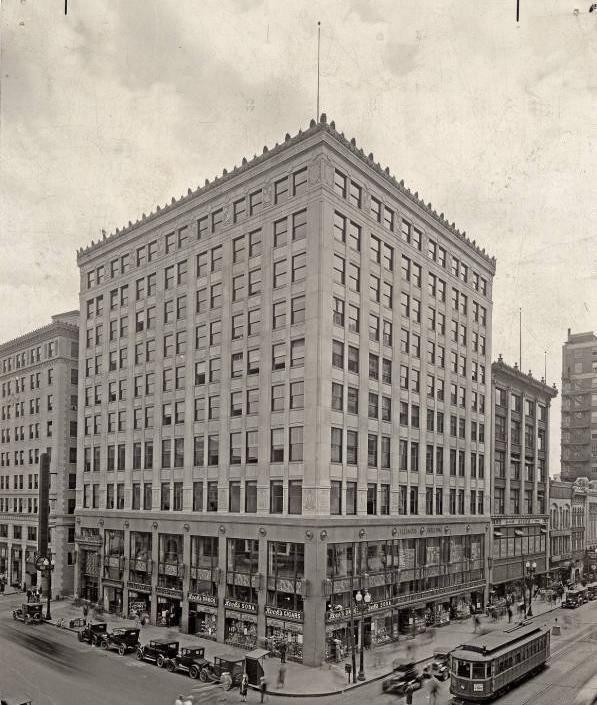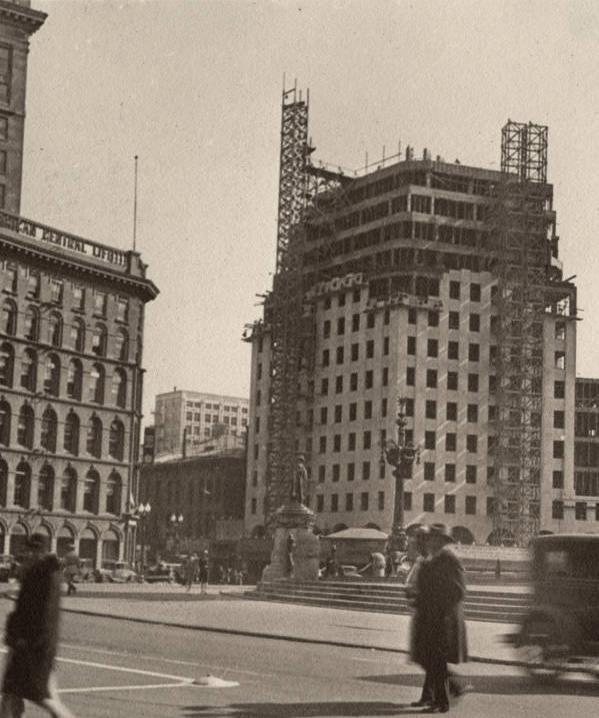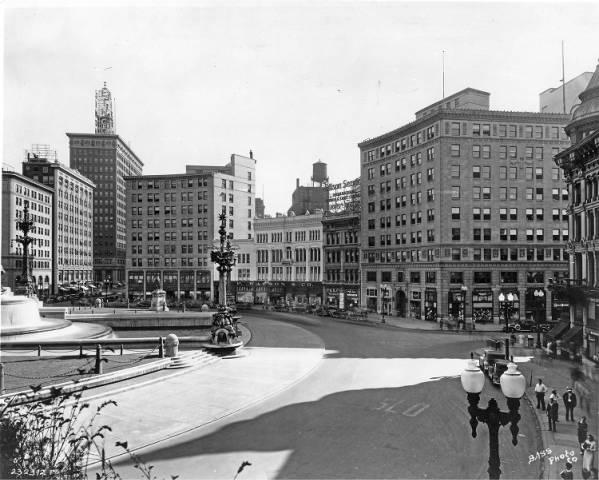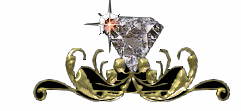|
|
SOLDIERS' AND SAILORS' MONUMENT
AKA
Monument Circle In 1862, long before the Civil War ended, a letter to the editor in the Indianapolis Daily Journal suggested that the state should "erect a monument . . . to the memory of all the dead of Indiana who have fallen in defense of the Union." Forty years passed between that suggestion and the dedication of the Monument in 1902.
At the very center of Indianapolis is the "State Soldiers' and Sailors' Monument". Recognized as one of the world's outstanding monuments, the structure has become the symbol of both Indiana and the city of Indianapolis. This 284-foot limestone monument was dedicated in 1902 and stands as a tribute to the valor of Indiana's soldiers and sailors who served in the Civil and Spanish American Wars.
Its
total height is 284 ft. 6 in. The monument is considered the largest of its kind in the United States that honors the everyday American soldier and sailor. The Limestone used for the monument is gray oolitic limestone from the Romona quarries of Owen County. "Monument Circle," as it is called today, is the site of frequent festivals and lunchtime concerts. The Monument and surrounding circle also provides a venue for a variety of civic and cultural events. Because of its status as a meeting place in the center of the city, several public activities and festivals are scheduled at or near the monument. It is used as a venue for an annual outdoor art display with an Indianapolis 500 theme. In June it plays host to the Chrysler Concourse Grand Prix, a mainstay of the Formula One celebrations in Indianapolis.
The
monument served as a spontaneous gathering place for revelers after
the Indianapolis Colts won Super Bowl XLI.
The
circle is the standard symbol of the city of Indianapolis, and the city's
flag is an iconic representation of Monument Circle and
the two streets (Meridian and Market) that feed into and out
of it. One of Indy's recognizable nicknames, "the Circle
City" comes from Monument Circle. For a panoramic view of the city, one can walk 230 feet up 32 flights of stairs with 330 steps for free or or take the elevator for a $2.00 charge to the glass enclosed balcony. The elevator was installed and began carrying the public to the top in April 1894. From the glassed-in observation area, the original city plan of Indianapolis is apparent, although modern high-rise buildings have begun to dominate the view. The outside of the circle is today surrounded by small retail shops, including the South Bend Chocolate Factory, studios for several local radio stations, the Hilbert Circle Theatre (home of the Indianapolis Symphony Orchestra), financial institutions, the Columbia Club (one of the oldest social clubs of Indianapolis), and Christ Church Cathedral, a historic Episcopal church. The circle is the standard symbol of the city of Indianapolis, and the Flag of Indianapolis is an iconic representation of Monument Circle and the two streets (Meridian and Market) that feed in and out of it. One of Indy's recognizable nicknames, "the Circle City", comes from Monument Circle.
State Soldiers' and Sailors' Monument" was designed by Bruno Schmitz, Germany's foremost architect of national monuments. The Monument appears to be Schmitz's only commission outside of Germany and Switzerland. Most of the bronze and stone sculptures on the Monument were designed, executed and manufactured by Germans. The limestone sculptures are the work of Vienna-born sculptor Rudolf Schwarz. It has been estimated that building a similar structure today would cost more than five hundred million dollars. The monument is a unique example of the sculptural art of its time, featuring images representative of both history and mythology. For generations, the Indiana Soldiers' and Sailors' Monument has stood majestically as a tribute to the past and an inspiration for the future. The monument has held up admirably well through time - the carvings and statues are still crisp, clean, and very readable. Although Indiana was geographically a border state, 74.3 percent of all eligible men served in the Union army, a percentage higher than every state except Delaware. More than 200,000 Hoosiers gave their lives to preserve the Union.
While it
was "Erected as a memorial to the soldiers and sailors of the
War for the Union," it was in fact dedicated to all of Indiana's
heroes who died in war before 1902:
The wars it commemorates are engraved on two side panels: There is one panel on the North side of the monument, with sculptures representing Artillery and Navy, and honoring soldiers of the War with Mexico, Indian & British Wars, Revolutionary War, and Vincennes, and the other, with the Civil War plaque and 2 sculptures representing Infantry and Cavalry,
There is one panel on the South side. The top bronze band of the monument contains two dates - 1861 and 1865, commemorating the start and end dates of the Civil War. On the east and west sides of the monuments are fountains and pools, containing a series of three cascades brilliantly illuminated at night.
The cascade fountains each hold a minimum capacity of seven thousand gallons of water per minute. The water for the fountains is supplied by wells beneath the Monument. The water flows from the terrace level down three tiers into the pool which is bordered by a molded stone curb. The corners of the fountain pools are marked by ornate bronze candelabra. Three sides of each pedestal have bronze bison-head foundations from which water spouts into the attached stone basin.
Though
the fountains are not intended for swimming, the city's children
rushed into them as part of celebrations for VE day. The announcement
of Victory in Europe brought hundreds to the circle and many dove
into the fountains. At the second-tier level are a second set of four candelabra, each 40 feet high, which rest upon sculpted stone pedestals, bearing bronze swags and American flag escutcheons. The four large bronze candelabra, four bronze fountain candelabra, and twelve bison heads were designed by Bruno Schmitz, They were modeled and executed in "hammered aluminum bronze" by the studio Bruno Schmitz, and cast in Berlin. Look closely at the ornate bronze candelabra on stone fountains. You will see that the shaft is fluted to represent stalks of corn. Notice the bison and bear heads and eagles. Near the top is a bronze band with "E Pluribus Unum". A sunburst finial tops the candelabra. Schulte, a German who was in charge of the work, spoke very little English. Many of the workmen had great difficulty in following instructions. Frank Langsenkamp, who did many of the castings, came to the rescue. With his help and knowledge of German, the candelabra were easily assembled. The model for the motto "To Indiana's Silent Victors" was furnished by Frank Fertig.
In 1897 Schmitz brought from Germany sculptor Rudolf Schwarz. He was hired essentially to do the "War" and "Peace" groupings (the larger ones on the east and west), designed by Bruno Schmitz and modeled by Hermann Matzen. The West-side group represents "Peace" with the returning soldiers. In the center, Liberty holds the flag, at her feet a freed slave lifts up a broken chain. A blacksmith, the soldiers marching home, and a husband and wife embracing with a child symbolize the return to families and peaceful pursuits. Above, The angel of peace holds the wreath of Victory and the olive branch of Peace.
In front of, and below, the "Peace" display is a limestone sculpture called "The Return Home". The East-side group represents "War." It is represented by a battle scene showing cavalry, charging infantry, and artillery. In the center the goddess of war urges on the charge, while Columbia in the background charges into battle with a torch held high.
The
sculpture includes a cavalry scout, men on horses charging into
battle, a drum and a cannon. Below, and to the front, of the "war" group is again a limestone sculpture, this one called "The Dying Soldier."
Schwarz
designed and sculpted the two related groupings below them, just
above the water: "The Dying Soldier" and "The
Return Home." The groupings on each side obviously
relate to each other; the larger allegorical "War"
and then beneath it the smaller (albeit still huge) grouping,
translates the allegory into human terms "The Dying
Soldier" while "The Return Home"
represents the homecoming of the victorious troops and the joyous
reunion of families. On the north and south sides, stone steps, 70 feet long, lead to bronzed entrance doors.
The Bronze Doors for all Monument entrances were designed and executed by Rudolf Schwarz and cast by American Bronze Company of Chicago. Above the entrance facing south is the inscription of dedication: "To Indiana's Silent Victors." Directly above the entrances are the rolls of honor inscribed with the State's contributions to America's armed conflicts. Four bronze statues stand surrounding the monument, one at each of the converging points of the street intersections. William H. English suggested that statues be erected to represent the leading men of noteworthy periods during Indiana's history.
John H.
Mahoney, of Indianapolis, also the sculptor of the two large figures
on the Pilgrims' Monument at Plymouth, Massachusetts, designed three
of the statues. The statue of Governor Morton was completed by Franklin
Simmons. There is a story that William Hoeltke, a German grocer on East Washington Street, served as a model for Harrison. The story goes that when Schwarz's finished work was viewed, all of the soldiers were bearded. This was deemed too German. So Schwarz patiently went to work and shaved the beards off with his chisel. The bronzework above the main part of the "base sculptures" encircling the Monument is called an "Army Astragal sculpture band".
It was designed by Nicolaus Geiger of Berlin who was noted for his naturalistic sculptures and public monuments, and was manufactured in Berlin along with the eight candelabra around the memorial.
The
lowest astragal, 70 feet above the monument base, is one of its
impressive features. It depicts the army and shows the implements and
carnage of war with cannons, horses, flags and fallen soldiers.
The
second astragal, 12 feet above the first, representing the Navy,
The
squared limestone shaft juts 284 feet, 6 inches into the air, and is
capped by a 38-foot high statue representing "Victory." Locals know the statue of Lady Victory at the top as "Miss Indiana."
In Lady
Victory's right hand is a sword, the point rests upon the globe,
symbolizing the army to which victory was due. Victory faces south,
supposedly to look over the vanquished battlefields of the South. The young eagle atop her head represents freedom.
The Monument was officially dedicated with impressive ceremonies on May 15, 1902.
The
Monument has been decorated for Christmas since 1945.
Every Christmas season the monument is decorated as an enormous Christmas tree. This city tradition is known as the Circle of Lights. The actual tree lighting ceremony is held the day after Thanksgiving. The decoration of the monument uses 4,784 lights and 52 strands of garland to create the 242 foot display. More than 100,000 people attend the ceremony and the event is televised to an even larger audience. The magic continues with toy soldiers and peppermint sticks encircling the Monument. One can also find the infamous scene of Jesus in a mager.
Snowflakes and stars will delight on-lookers as they dance across the skyline, and icicle flags on light poles will add shimmer to the walkways as a glow is cast from 63 lighted trees surrounding the Circle. The monument was last remodeled in 1987. The Indiana War Memorials Commission will spend $600,000 to repair the Soldiers and Sailors Monument in downtown Indianapolis beginning in August of 2009. The project to rebuild a leaky observation deck and shore up the monument's interior is scheduled to start Aug. 21 and finish by Sept. 25. Water is entering through the exterior of the observation deck and liberty statue and has deteriorated part of the statue's support system, "Victory is 38 feet tall. She weighs 19,300 pounds. There's 16 different supports that hold her up there," said J. Stewart Goodwin, executive director of Indiana War Memorials. "Five of the 16 had corrosion -- obviously a bad day for her to fall off there." The repairs will cost as much as the monument's original construction costs. Interior construction work had already begun, but was more involved than originally expected, which pushed the outside work schedule back. Repairs were needed to five of the 16 steel supports for the observation deck and the "Lady Victory" statue. Crews also have installed new vertical windows for the observation deck to prevent the water leaks from the previous slanted windows. In addition, a new observation deck will be installed that will be a bit larger and climate-controlled. Anchors are also being installed designed to help hang holiday lights that make the monument a tourist draw during the Christmas season. Six months and about $450,000 later, the windows are vertical instead of slanted, and Lady Liberty has been repaired, restoring the observation deck to the same look it had in 1930. The statue atop the monument still needs more repairs. Next summer (2010), workers will re-bronze the statue. Restoration of Soldiers' and Sailors' Monument in downtown Indianapolis has improved its accessibility without detracting from its appearance. As part of the project, ornate bronze doors were retained but updated to current safety codes by reversing them to open outward and installing exit devices that match their original appearance. After an $11 million renovation project that lasted over three years, the monument is now actually better than when it was new. General contractors for the restoration project were: Phase I - Geupel-DeMars, Indianapolis, and Phase II - Jungclaus-Campbell, Indianapolis. The first phase, primarily cleaning exterior limestone and bronze, as well as repairing several fountains, accounted for about $4 million of the cost and took place in 1986 and 1987. The more extensive second phase, begun after the Tenth Pan American Games in 1987, focused on bringing the structure up to current building codes and making it more functional by adding emergency systems and fire alarms, revising entry approaches and doors, rebuilding exterior steps to eliminate basement leakage, repairing mechanical services and installing a new elevator. The original steps surrounding the base of the monument also formed the ceiling of the basement below it, which was used at one time as a military history museum. Leakage and low headroom eventually made the area undesirable and led to a complete rebuilding. Originally, brick arches spanned limestone piers. These were replaced by cast concrete replicas that duplicated the varying contours of the originals. Structural slabs were added beneath the steps, which were selectively replaced and present the same exterior appearance as before. The basement floor was lowered 30" in most places, to provide added headroom for future use of the subterranean area. Four sets of doors leading to the lower area posed a special problem. Originally, the ornate bronze pairs of doors swung inward, as was typical when the monument was built. Modern safety considerations dictated that the doors open outward and be equipped with exit devices to assure safe egress. Similar doors accessing the upper level were left to open inward, since these will be left open during hours of operation, with glass outer doors installed to protect the area against weather. The challenge was to reverse the lower-level doors so they opened outward without changing their appearance. Prange explained, "We actually took the door frame out and swung it around, then had the frame reworked to keep the doors in the same plane." At the same time, exit devices were added for safety, with traditional cross-bar styled Von Duprin 88 Series vertical rod exit devices chosen to maintain the feeling of the era. These have a custom antique finish to closely match the finish of the bronze doors after they received extensive cleaning and a lacquer coating to bring out and protect their original richness. Several other facets of the project were also aimed at upgrading accessibility, for visitors both with and without handicaps, while also maintaining aesthetics. A small elevator has been replaced with a more attractive one of bronze and glass construction. This will enable visitors to reach an observation deck near the top of the 284-foot monument, which stands only 15 feet shorter than the Statue of Liberty. Handicapped access was also improved with the addition of ramps in several areas, and railings were installed for safety. At the lower level of the Monument is a Civil War exhibit.
Hours
of Operation
In 1918 Colonel Oran Perry created a photo gallery of military history in the lower level. The museum is located in the lower level of the Indiana State Soldiers' & Sailors' Monument, it presents the story of the Hoosiers in the Civil War and the builders of the monument. Photographs, documents, and objects allow visitors a glimpse of life from 1860 to 1902, during the Civil War. The Monument's museum contains artifacts from the Civil War and the Spanish American War. A few of the items on display are cannons, uniforms, letters and personal diaries written by Hoosiers during the war and a piece of the Maine.
With a variety of exhibits the museum also has a re-enactment video to engage the visitor in real war situations. Stepping into the Colonel Eli Lilly Civil War Museum is like stepping 150 years back in history to a time when our nation was divided into North and South and cannon fire could be heard throughout the country. Marking the center point of Monument Circle, located near IUPUI, Lucas Oil Stadium, and Circle Center Mall, the Colonel Eli Lilly Civil War Museum is a great place to experience Indiana's involvement in the Civil War. Taking place over a series of concise, beautifully rendered displays and exhibits, the Museum escorts its visitors through important time periods in the Civil War. The museum, named after one of Indianapolis's most famed citizens, Colonel Eli Lilly, is a great place to bring Indianapolis kids to give them an educational boost after a day of exciting fun at Climb Time or Fastimes Indoor Karting. This slice of history is sure to entertain them so much that they'll forget they're learning valuable lessons about honor, courage, and Indianapolis. Comprised of "vignettes" that take the viewer on a trip through time back to the Civil War days, the Colonel Eli Lilly Civil War Museum offers such a powerful experience that no visitor leaves unchanged. It's right at the top of the list of Indianapolis attractions. A sense of great involvement in history is conveyed to the visitor of the museum through sculpture, video, and interactive maps. You can experience the anticipation and dread of an upcoming battle, and the tension felt by family members left at home. You will even be able to read authentic letters from soldiers to their families. One of the highlights of the Colonel Eli Lilly Civil War Museum is the connecting corridor between the two main galleries. It truly gives visitors the sense of being a marching soldier, with great details like a rutted dirt path and a covered bridge. In addition to taking in the sights and sounds of battle, visitors will also encounter the rigors of hospital and prison life, probably making them thankful that they live in a modern era. If you haven't had your fill of history after leaving the Colonel Eli Lilly Civil War Museum, why not head over to the Indiana State Capitol Building just a few blocks away? The Museum isn't far from many other Indianapolis attractions, and it's a great compliment to any day about town. Located:
Colonel
Eli Lilly Civil War Museum To view an enlarged map, click on the section of the map you wish to see, or select a section below. The Monument rises from a circular plaza, 342 feet in diameter, where once stood the governor's house - but where no governor ever lived. Read a little detail on the Governor's House along with The Governor's House being haunted. The "mile square" was patterned after Washington, D.C. The center was known from its beginnings as the "Governor's Circle," since according to Ralston's plan, the Governor's mansion was to be built there. The geometric pattern of roadways would spread from the circle, surrounded by the circular plaza, with four diagonal avenues leading outward, and streets that cross at right angles.
In 1821 the mile square was still almost unbroken forest with only a few cabins within miles. Weather conditions added to the early settlers' difficulties. Dense underbrush, decaying vegetation, mosquitoes and other insects brought an epidemic of illness that was finally stopped by cold weather. In the years following, new settlers came with astonishing rapidity, and the 40 cabins in 1822 increased to one hundred in 1825. Also in 1822, a market house was built in the center of the Governor's Circle, with market held every Saturday, until 1824. In 1827 the Assembly voted $4,000 to build the Governor's mansion, the final cost was closer to $6,500. Neither Governor James Brown Ray nor any other governor ever lived there, but it housed a diverse array of tenants. Seldom has one house had such a variety of uses. Finally, in 1857 the Governor's Mansion was demolished. The Civil War brought much activity to the Governor's Circle, including young men congregating to be mustered into service. During the war and the years immediately following, the city grew rapidly. Until the 1860s, many lots on the circle were owned by churches. Congregationalists, Presbyterians, Methodists, and Episcopalians all built simple frame chapels facing the circle. Only the Episcopal Church remains today; Christ Church Cathedral is a stone Gothic Revival sanctuary dating from the 1860s.
Gradually, the congregations found their members living farther and farther away, with office and commercial uses crowding out their church buildings. Merchants bought up the church sites. In 1867 the City Council ordered the Governor's Circle graded, fenced, walks laid out, benches placed, and the whole encircled by a sidewalk. Its name was changed to "Circle Park."
There had
been talk and early attempts at building a war monument. In 1875 a
Monument Association was formed and it raised $1,000. Since plans did
not materialize, the money was set aside. Several locations had been
proposed, including Crown Hill Cemetery. In 1887 the Indiana General Assembly passed a bill committing the state to build a state monument to honor the veterans of the Civil War. The legislature made a grant of $200,000, appointed a Monument Commission and ordered the commissioners to build the Monument "on the ground commonly known as Circle Park." The appointed commission held an international architectural competition for the design of the memorial. Ten outstanding American architectural firms were invited to submit designs, among them Frederick Baumann of Chicago and Adolph Scherrer of Indianapolis. Also advertisements were placed in the newspapers of leading cities in the United States, Canada, England, France, Germany and Italy, inviting architects to enter into the competition. Seventy designs were submitted and, to conceal the contestants' identity, entries were identified by number only. The Commissioners and their Board of Experts chose the shaft design of Number 4. The winning entry design of Number 4, for a towering obelisk, fountains and monumental sculpture, was by Bruno Schmitz of Berlin. His work was familiar to the commissioners as he and James F. Gookins, the secretary of the board, had been fellow artists and friends in Munich. Schmitz was invited to Indianapolis and was appointed supervising architect in February 1888. Frederick Baumann of Chicago was appointed deputy architect and authorized representative for Schmitz. Schmitz was no stranger to Indianapolis. Otto Lieber, who lived in Schmitz's home town of Düsseldorf, had introduced him to his brother Hermann Lieber of Indianapolis, and to Julius Lemcke and Theodore Stempfel. While in Indianapolis he usually stayed with the Liebers or the Lemckes. In May 1888 the contract for the central foundation was let to Enos Hege of Indianapolis. It was completed by the end of the year. In January 1889 Schmitz brought a plaster model of the monument, and on August 22, 1889, the cornerstone was laid. In it is as large box containing reports, a list of all soldiers from Indiana who fought in the War for the Union, and other items including a photograph of Schmitz. The inscription on the cornerstone reads:
August
22, 1889 The completion of the monument in 1902 made the circle a civic space. The circle's gradual transformation into a business, commercial, and civic core was complete. The Monument, commemorating the war between the States, was the first in the nation to be dedicated to the common soldier. It took twelve years to complete at a cost of $598,318 in 1902. It has been estimated that building a similar structure today would cost more than five hundred million dollars. Architects of several generations have had to contend with fitting their design concepts into a concave footprint to match the radius of the circle. Early architects chose to ignore the radius and placed conventional buildings at a tangent to the circle. By the 1870s and 80s, however, the freedom of expression that came with cast-iron fronts allowed builders to warp façades easily. One of the best remembered buildings on the circle, the English Hotel, filled a quarter-radius of the circle with its Italianate/Queen Anne façade. The English Hotel succumbed to progress after World War II. A Penney's store replaced it with a Modernist curving blank limestone curtain wall. Eventually, Penney's vacated the store, and a Postmodern façade now fills the northwest quadrant of Monument Circle. Indiana limestone became the most popular building material for the new generation of buildings lining Monument Circle. The Guaranty and Test Buildings, both from the 1920s, occupy portions of the southwestern quadrant.
These two show the refinement and quality of Monument Circle's architecture, with their curved facades, tasteful Neo Classical design, and respectful height that allows the State Soldiers and Sailors Monument to stand tall. The Test Building also features sculptural panels. Other buildings on Monument Circle have public art: Circle Theater, with its terra-cotta frieze and mural over the marquee; the Columbia Club with its sculpted panels; and Circle Tower's intricately cast neo-Egyptian brass screens set in the main entrance arch.
However impressive, the technological innovations of 1920s architecture raised concerns. Would Indiana's revered c. 285 tall State Soldiers and Sailors Monument, completed only two decade before, be cast into shadow by steel-framed skyscrapers?
In 1921-22, local architect William Earl Russ and city leaders proposed, and the city implemented, local legislation that limited heights to 10 stories and called for elevation setbacks to preserve the prominence of the monument. George Edward Kessler had made the initial suggestion to the city during his years as a consulting park planner. Circle Tower, with its Deco stair-step roofline, is the most obvious example of how the legislation shaped architecture on the circle. The Emmis Building, completed in the 1990s, also reflects the setback design concept.
Attempts to beautify Monument Circle took shape after the war years in the late 1940s. Architect Edward Pierre was a leading home, business, and civic designer in Indianapolis in the 1920s and 30s. Pierre, then near retirement, made suggestions about revitalizing the circle. Among others, he recommended that Monument Circle and the Monument itself be strung with holiday lights. Thanks to his idea, visitors lucky enough to be in downtown Indianapolis during the holidays will experience the magical effect of the lighting. The City of Indianapolis hoped to improve the image of the circle in the 1970s. Workers laid paving bricks on Monument Circle and Market Street and installed brick walks. Names of donors to the project were inscribed on the sidewalk bricks. In the 1970s, the downtown was developing into a sports destination, with the Indiana Pacers playing at the then-new Market Square Arena. The Indiana State Museum was downtown in the Old Indianapolis City Hall, but the downtown lacked other major cultural draws. In the early 1980s, city officials lured the Indianapolis Symphony Orchestra downtown to the old Circle Theater, turned into a fitting home for the symphony, thanks to a multimillion dollar restoration. Today, Monument Circle more than fulfils the civic ideas Alexander Ralston had for Indianapolis. The poem America, Messiah of Nations was written by James Whitcomb Riley for the dedication of the Indiana Soldiers' and Sailors' Monument, and was transformed into a march by John Philip Sousa. Both Riley and Sousa performed the poem and march at the dedication ceremonies.
In
the need that bows us thus, America!
Lift
the trumpet to thy mouth, America!
High
o'er looking sea and land, America!
Thine
a universal love, America!
|
||||||||||||||||||||||||||||||||||||
